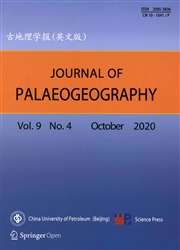Asia–Gondwana connections indicated by Devonian fishes from Australia:palaeogeographic considerations
作者:Gavin Charles Young,Jing Lu
摘要:Middle Palaeozoic vertebrate fossil occurrences are summarised for Australia, with reference to faunal connections between Asia and East Gondwana, as first indicated by fish distributions of Lower Devonian fossil sites. Major endemic groups discussed are pituriaspid(Australian) and galeaspid(Asian) agnathans, wuttagoonaspids(Australian)and antarctaspid(Antarctic, Australian, Asian) arthrodires, yunnanolepid and sinolepid antiarchs(South China,Indochina terrane, Australia), and early tetrapodomorphs(South China, Australia). More widespread groups that lived in shallow marine environments(lungfishes, buchanosteid arthrodires, antiarch Bothriolepis) also show species groups shared between South China and East Gondwana. Exchange of continental facies fishes(e.g. tristichopterid tetrapodomorphs) may have been interrupted by marine transgression in the Frasnian, but were restored in the late Famennian with the appearance of Grenfellaspis in eastern Australia, the only sinolepid antiarch known from outside Asia. The hypothesis of Gondwana dispersion and Asian accretion, to explain the collage of geological terranes forming modern east and southeast Asia, implies increasing dissimilarity with increasing age, but the SiluroDevonian early vertebrate evidence is inconsistent with this. Previous cladistic analysis of Asian terranes predicted galeaspid agnathans on the Indochina terrane, and their subsequent discovery at Ly Hoa, Vietnam, confirms that Indochina and South China had come together across the Song Ma suture by Middle Devonian time.
发文机构:Department of Applied Mathematics Australian Museum Research Institute Key Laboratory of Vertebrate Evolution and Human Origins of Chinese Academy of Sciences CAS Center for Excellence in Life and Paleoenvironment
关键词:DEVONIANPALAEOGEOGRAPHYBiogeographyVertebratesEastGondwanaSouthChinaIndochinaterrane
分类号: P534.4[天文地球—古生物学与地层学]Q915[天文地球—地质学]
- Genus Pronephrium Presl 1851 (Thelypteridaceae) in Romania
- Ancient rip current records and their implications: an example from the Cretaceous Ukra Member, Kutch, India
- New freshwater plesiosaurian materials from the Middle Jurassic Xintiangou Formation of the Sichuan Basin, southwestern China
- First steps in reconstructing Early Jurassic sea water temperatures in the Andean Basin of northern Chile based on stable isotope analyses of oyster and brachiopod shells
- A facies and palaeogeography-based approach for analysis of petroleum systems in United Arab Emirates
- The complexity of climate reconstructions using the coexistence approach on Qinghai-Tibetan Plateau
- The use of mineral interfaces in sand-sized volcanic rock fragments to infer mechanical durability
- Fruits of Scirpus (Cyperaceae) from the early Miocene of Weichang,Hebei Province, North China and their palaeoecological and palaeobiogeographical implications
- Words of the Editor-in-Chief——some ideas about the comments and discussions of hyperpycnal flows and hyperpycnites
- Summary of Editorial Committee Meeting (January 5, 2020) of Journal of Palaeogeography


